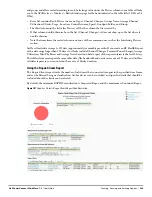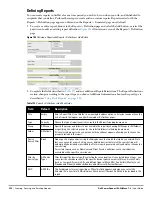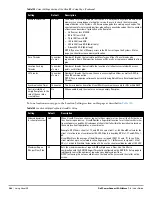
258
| Using VisualRF
Dell PowerConnect W-AirWave 7.4
| User Guide
Features
Floor plan upload wizard enables direct importation of JPEG, GIF, PNG, PDF and CAD files for floor plans.
Batch upload wizard enables batch uploads of multiple CAD files with corresponding walls, and access points.
Accurate calculation of the location of all client devices (laptops, RFID Tags, PDAs, Phones) using RF data
from your existing APs and controllers. Further improvements in accuracy can be achieved with site surveys.
Tree view allows you to navigate to a specific campus, building, or floor via a tree navigation.
Heatmaps depict the strength of RF coverage in each location.
Speed (data rate) view which depicts the highest possible speed at every location on a floor plan.
Built into the AirWave Management Platform for onscreen display of alerts and error conditions. For
instance, an AP icon will display in red when a critical alert is active or when usage conditions exceed pre-
defined thresholds.
Location playback viewer which allows visual tracking of up to 24 hours of location history.
Dynamically recalculates path loss and device locations based on real-time data from your wireless LAN, for
increased location accuracy.
Calibrates RF data from multiple vendors' APs (and across different product lines from the same vendor) for
accurate display even in multi-vendor and multi-architecture environments.
Full planning capabilities based on speed or signal requirements.
Useful Terms
VisualRF - The AirWave service that calculates location, calculates path loss, and provides floor plan editing
capabilities.
VisualRF Plan - Makes the planning portions of VisualRF available in an offline software package that does
not require a server. For more information about VisualRF Plan, see
“About VisualRF Plan” on page
293
.
QuickView - Flash front-end for VisualRF which displays information generated by the backend service.
mW - 1/1000 of a Watt. It is a linear measurement (always positive) generally used to represent transmission.
dB (Decibels) - difference/ratio between two signal levels.
dBm - dB as compared to 1 mW. It is a logarithmic measurement (integer) which is typically used in place of
mW to represent receive-power level. AMP normalizes all signals to dBm, so it is easy to evaluate performance
between various vendors.
RSSI (Received Signal Strength Indicator) - IEEE defines RSSI is a mechanism by which RF energy is to be
measured by the circuitry on a wireless NIC (0-255). RSSI is not standard across vendors. Each vendor
determines their own RSSI scale/values.
AP-to-AP Signal (Neighbor) - Some APs/Controllers have the ability to report the signal strength of APs that
they hear. AMP uses these signal strength readings to dynamically attenuate floor plans to increase the
accuracy of client locations and heat maps.
Unassociated Client Information - Some APs/Controllers have the ability to report the signal strength clients
they hear, but that are associated to a radio on a neighboring AP. AMP also uses these signal strength
readings to more accurately place clients.
Client Surveys - Client surveys within VisualRF use access points to understand which clients they hear and
at what signal strength.
Rogue Surveys - Rogue surveys are facilitated by AMC, VisualRF and the client's radio to understand which
access points they hear and what signal strength.
Starting VisualRF
In order to launch VisualRF, it must be enabled within AirWave Setup to display the VisualRF tab, and the
VisualRF engine must be switched on in VisualRF > Setup. Both of these pages are visible to logged-in
administrators only. By default, VisualRF is disabled in new AMP installations.
Summary of Contents for PowerConnect W-Airwave
Page 1: ...Dell PowerConnect W AirWave 7 4 User Guide ...
Page 106: ...106 Configuring and Using Device Groups in AirWave Dell PowerConnect W AirWave 7 4 User Guide ...
Page 256: ...256 Creating Running and Emailing Reports Dell PowerConnect W AirWave 7 4 User Guide ...
Page 310: ...310 Index Dell PowerConnect W AirWave 7 4 User Guide ...
















































